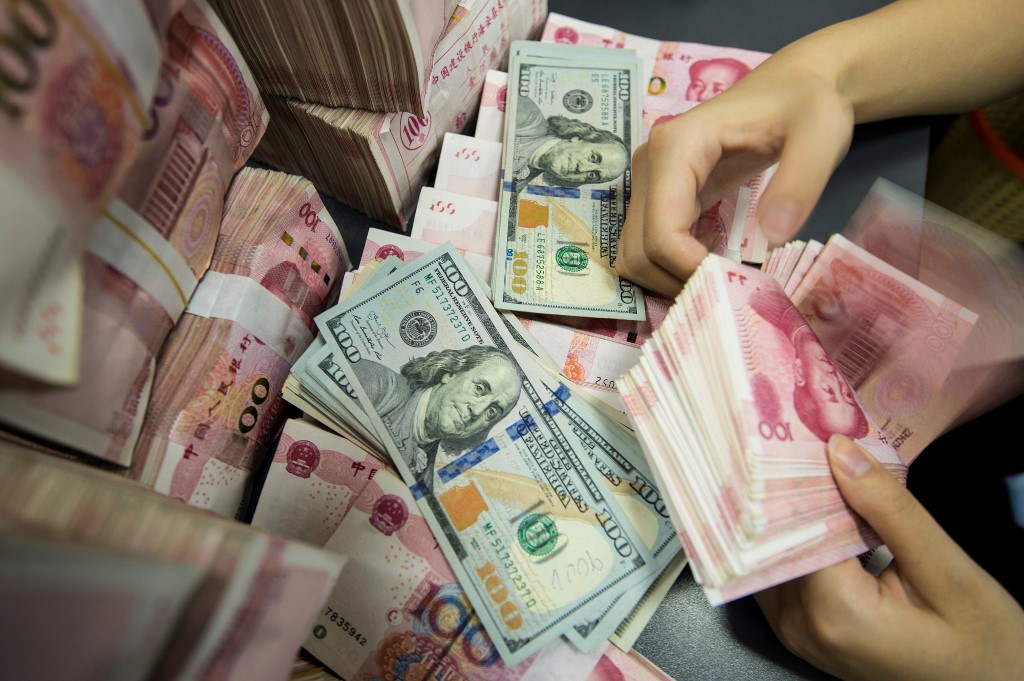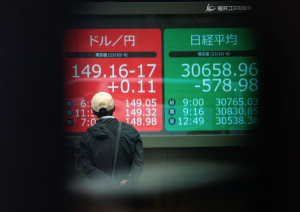China’s yuan is facing the most sustained depreciation pressure since 2015, when a shock devaluation triggered a global stock market rout.
Like back then, China is in a slow-growth phase and its central bank is easing monetary policy to support the economy. Also like 2015, analysts are mostly bearish on the outlook for the yuan, even after it stabilized in the second half of May as Covid lockdowns eased.
“Shifts in monetary policy…bond portfolio allocations and slowing Chinese growth will all combine to weaken the currency,” says Peter Kinsella, global head of forex strategy at London-based private bank Union Bancaire Privée. “The Fed is increasing the pace of rate hikes, while the PBoC is moving towards further incremental easing. This puts further pressure on the exchange rate.”
READ MORE: China’s Yuan at Two-Week High as US Ponders Tariff Cuts
The yuan is down about 5% against the dollar so far this year. It shed 6.25% in ten days in April, falling faster than it has in nearly seven years. It plunged to its lowest in 19 months on May 12, when it hit 6.76 to the dollar after US inflation data rose at the fastest pace in more than 40 years, indicating higher US interest rates and a wider yield gap with China.
The gap between US and China yields widened again last Wednesday, when the Fed hiked interest rates by 75 basis points, the steepest rise since 1994.
And it’s poised to widen further. In its so-called dot-plot forecast, the Fed sees its federal funds rate rising to a mid-range of 3.4% this year and to 3.8% by the end of 2023, compared with a range of 1.5% to 1.75% now.
China though is likely to cut interest rates again as it strives to boost an economy that’s been hammered by Covid lockdowns.
It cut its benchmark one-year loan prime rate by 5 basis points in December and by another 10 basis points in January. Oxford Economics expects another cut in the third quarter.
So where does the yuan go from here? Even with an easing in Covid lockdowns in recent weeks, a rebound in May exports, and stocks that are outperforming global benchmarks, there remains pressure for yuan depreciation.
“China’s renminbi will likely remain weak for the rest of this year,’’ says Tommy Wu, a Hong Kong-based lead economist at Oxford Economics. “While asset valuations look attractive and policy easing could help prop up China’s growth in the second half, we think global investors’ appetite for Chinese assets will remain low as China’s outlook is highly uncertain due to the zero-Covid policy.’’
Here’s a closer look at the key reasons for the bearish outlook, together with some specific forecasts:
Yield Gap
The divergence in monetary policies is pulling money away from yuan assets to increasingly more attractive dollar-denominated ones, and that’s putting downward pressure on the yuan.
In April, the premium that Chinese Government Bonds (CGBs) held for more than a decade was erased. So far this year, the yield on 10-year US Treasuries has climbed some 172 basis points and is now about 40 basis points higher than on CGBs.
Growth
Despite recent signs of improvement as Covid lockdowns ease, Nomura Holdings does not yet see “a turning point” for the economy.
Beijing’s strict adherence to its zero-Covid policy, an imploding property sector, and a large government funding gap will continue to weigh on growth, says Nomura’s Chief China Economist Lu Ting in Hong Kong.
Goldman Sachs downgraded its growth forecast for the year to 4% from 4.5% in mid-May, mainly because of the drag from lockdowns caused by the zero-Covid policy. It says the policy may well extend into 2023 and sees the official 5.5% growth target as ‘’unachievable.’’
The World Bank this month slashed its growth estimate for the year to 4.3% from 5.1%. UBS slashed it’s forecast on May 24 to just 3%, from 4.2% previously, citing “the lingering restrictions and lack of clarity on an exit strategy from the current Covid policy.’’
Capital Outflows
In March, portfolio outflows from China surged to a record $17.5 billion. Bank of America estimates a total of some $159 billion flowed out of equities, bonds and deposits in the first quarter, calling it the “sharpest drop over a three-month period since the data became available in 2014.”
While there was a small net inflow of $4.7 billion in May, foreign holdings of CGBs slumped for the fourth consecutive month with net sales of 110 billion yuan ($16.4 billion), according to central bank data released on Wednesday.
Yuan Outlook
So where does the yuan land?
Based on earlier depreciation cycles that began in 2015 and 2018, the yuan is likely to remain under pressure for 12 to 18 months, says Song Xuetao, chief macroeconomic analyst with Beijing-based TF Securities.
- Bank of America revised its year-end forecast to 7 from 6.8 to the dollar on June 7, citing factors including US dollar strength, yen depreciation, and geopolitical tensions.
- The China Center for Economic Research at Peking University is a little more optimistic. It expects the yuan to move in a range of 6.7-6.85, it said on June 7, citing factors including the recurrence of epidemics in many places in China, the inversion of the interest rate gap between China and the US, substantial downward pressure on the economy, and international geopolitical conflicts.
- Jefferies Financial Group expects the yuan to fluctuate between 6.6 to 7 in the second half. Says Hong Kong-based analyst Chen Shujin, “If China again carries out extensive Covid lockdowns or the Russia-Ukraine conflict impacts China, investors will become more pessimistic on China’s economy and the yuan.”
•By Neal McGrath and Iris Hong
ALSO ON AF: Banks Forecast Weaker Yuan as Drive for Dollars Grows
China’s Weak Yuan Also Suggests a Weak Stock Market: UBS
























